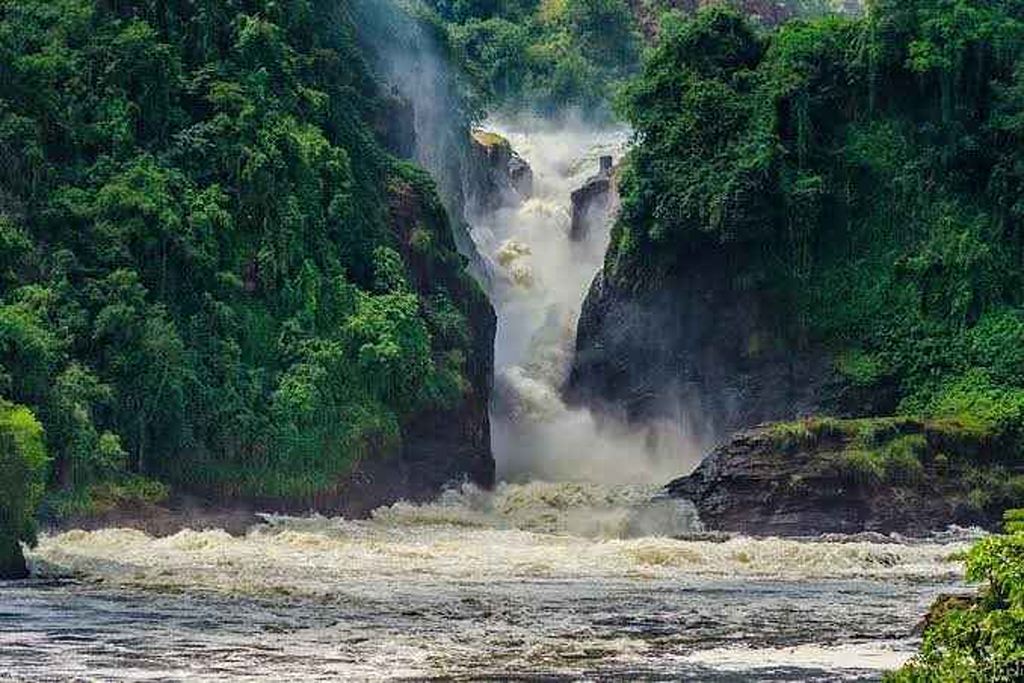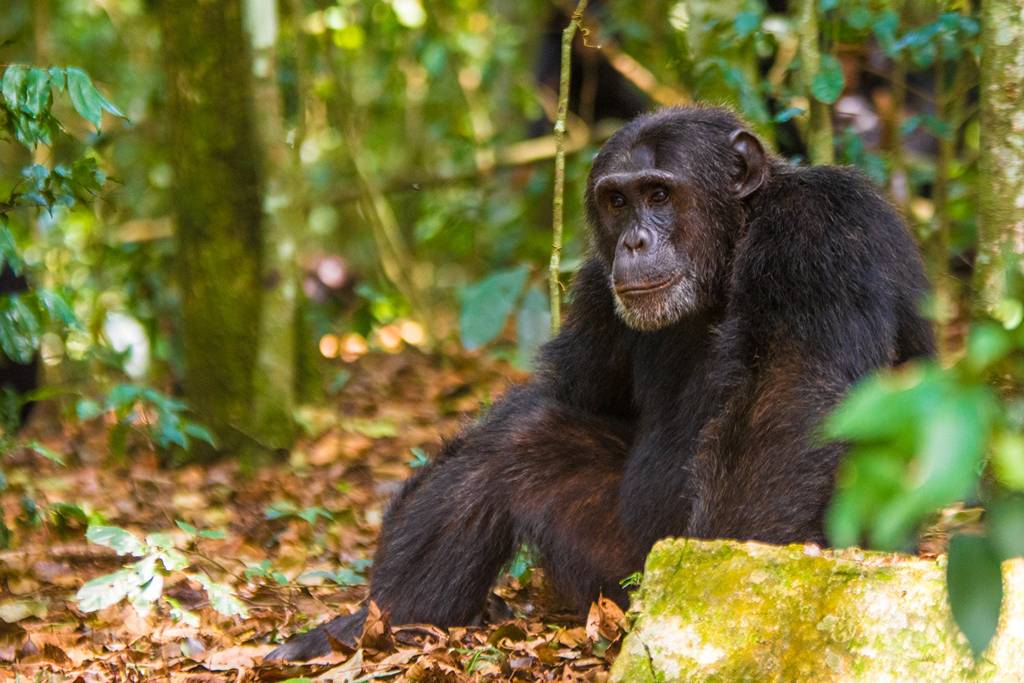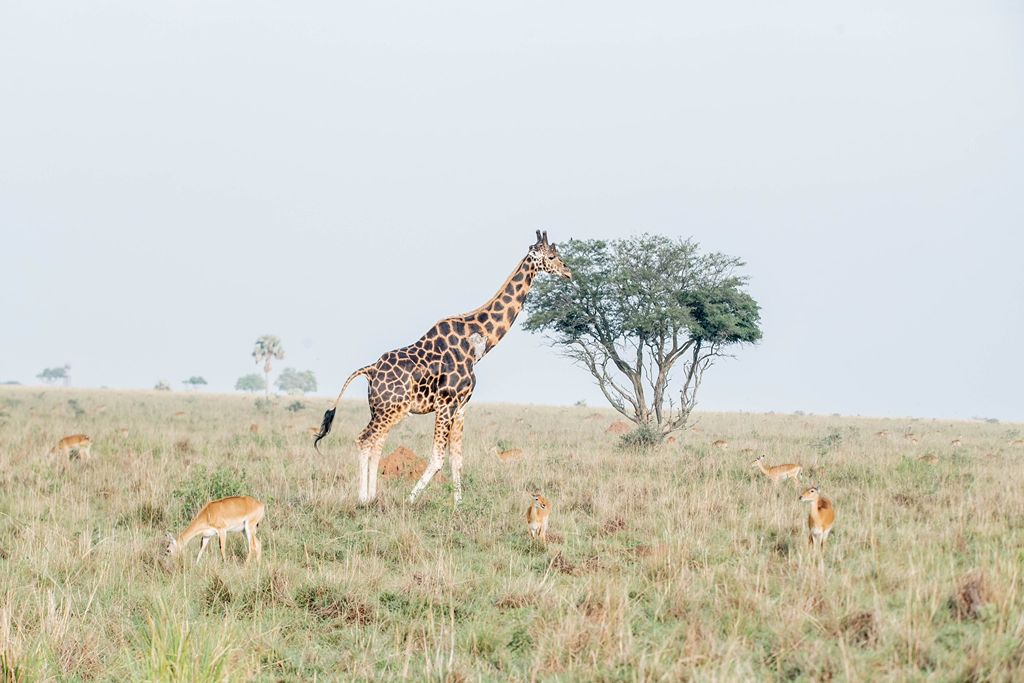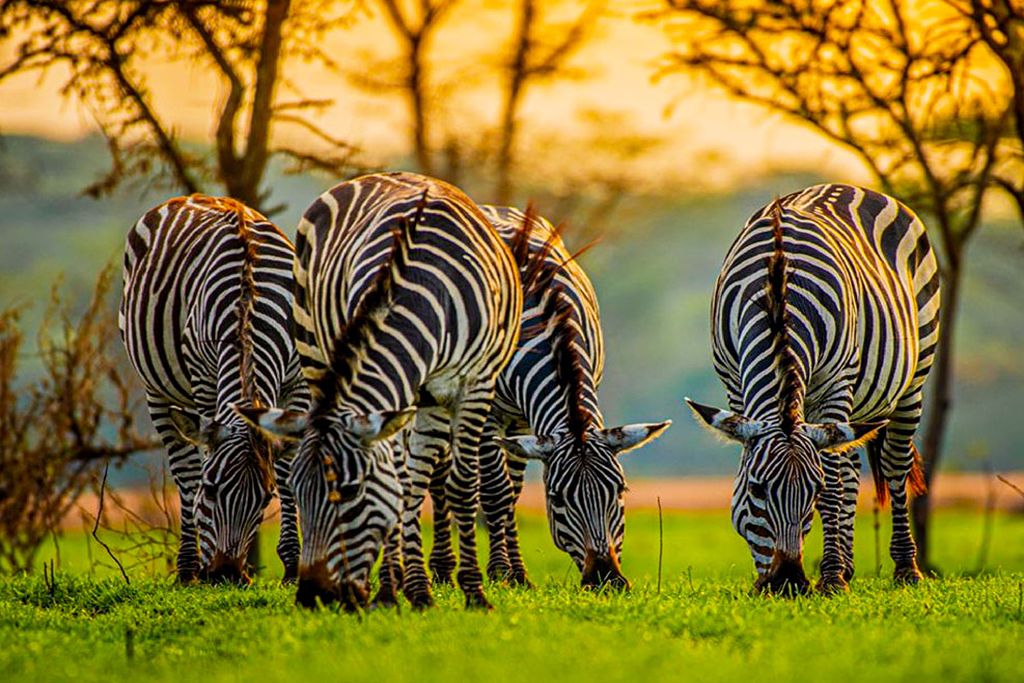ugANDA
Uganda, officially known as the Republic of Uganda, is a landlocked country in East Africa. It is bordered by Kenya to the east, South Sudan to the north, the Democratic Republic of the Congo to the west, Rwanda to the south-west, and Tanzania to the south. Uganda also shares a significant portion of Lake Victoria, one of the largest freshwater lakes in the world, with Kenya and Tanzania. The capital city of Uganda is Kampala, which is also the largest city in the country. The official languages are English and Swahili, though Luganda is widely spoken as well. The country is known for its diverse landscapes, which include savannas, lakes, mountains, and dense forests. Uganda has a rich cultural heritage with over 50 ethnic groups, each with its own unique traditions and languages. The country is famous for its wildlife, particularly the endangered mountain gorillas that inhabit the Bwindi Impenetrable Forest. Other popular national parks include Queen Elizabeth National Park, Murchison Falls National Park, and Kibale National Park. The economy of Uganda is primarily based on agriculture, which employs the majority of the population. Key agricultural products include coffee, tea, cotton, tobacco, and various fruits and vegetables. In recent years, Uganda has also experienced growth in sectors such as oil and gas, tourism, and telecommunications. Uganda gained independence from Britain on October 9, 1962. Since then, it has gone through periods of political instability and conflict, but has made significant progress in recent years towards stability and development. The current president is Yoweri Museveni, who has been in power since 1986. Uganda is known for its warm and welcoming people, vibrant culture, and breathtaking natural beauty, making it a unique and captivating destination for visitors.

1. Bwindi Impenetrable National Park
- Facts: Home to nearly half of the world's mountain gorillas.
- What to do: Gorilla trekking, bird watching, nature walks.
- Lodges: Buhoma Lodge, Gorilla Forest Camp, Bwindi Lodge.
- Location: Southwestern Uganda.
- Facts: Famous for its diverse ecosystems, including savannas, forests, and wetlands.
- What to do: Game drives, boat cruises on the Kazinga Channel, chimpanzee tracking.
- Lodges: Mweya Safari Lodge, Katara Lodge, Kyambura Gorge Lodge.
- Location: Western Uganda.

3. Murchison Falls National Park
- Facts: Known for the world's most powerful waterfall, Murchison Falls.
- What to do: Game drives, boat cruises on the Nile, hiking to the top of the falls.
- Lodges: Paraa Safari Lodge, Chobe Safari Lodge, Murchison River Lodge.
- Location: Northwestern Uganda.

4. Kibale National Park
- Facts: Contains one of the highest primate densities in the world.
- What to do: Chimpanzee tracking, bird watching, forest walks.
- Lodges: Primate Lodge, Kibale Forest Camp, Crater Safari Lodge.
- Location: Western Uganda.

5. Kidepo Valley National Park
- Facts: One of Africa's most remote parks, known for stunning scenery.
- What to do: Game drives, cultural tours, bird watching.
- Lodges: Apoka Safari Lodge, Kidepo Savannah Lodge, Nga’Moru Wilderness Camp.
- Location: Northeastern Uganda.

6. Lake Mburo National Park
- Facts: The smallest of Uganda’s savannah national parks.
- What to do: Game drives, boat cruises, horseback safaris.
- Lodges: Mihingo Lodge, Rwakobo Rock, Lake Mburo Safari Lodge.
- Location: Western Uganda.

7. Mount Elgon National Park
- Facts: Features one of the largest calderas in the world.
- What to do: Hiking, bird watching, exploring caves.
- Lodges: Sipi River Lodge, Mount Elgon Hotel, Kapkwai Forest Cottages.
- Location: Eastern Uganda.
8. Rwenzori Mountains National Park
- Facts: Known for the Rwenzori Mountains, also called the "Mountains of the Moon."
- What to do: Mountain climbing, nature walks, cultural tours.
- Lodges: Equator Snow Lodge, Ruboni Community Camp, Rwenzori Trekkers Hostel.
- Location: Western Uganda.
9. Semuliki National Park
- Facts: Known for its hot springs and diverse wildlife.
- What to do: Bird watching, nature walks, visiting hot springs.
- Lodges: Ntoroko Game Lodge, Semuliki Safari Lodge, UWA Bandas.
- Location: Western Uganda.
10. Mgahinga Gorilla National Park
- Facts: Part of the Virunga Volcanoes, home to mountain gorillas and golden monkeys.
- What to do: Gorilla trekking, golden monkey tracking, volcano hiking.
- Lodges: Mount Gahinga Lodge, Amajambere Iwacu Community Camp, Mucha Hotel.
- Location: Southwestern Uganda.
The best time to visit Uganda is during the dry seasons, which typically occur from December to February and June to August. These periods are ideal for wildlife viewing, as animals are more likely to congregate around water sources. Additionally, the weather is generally more pleasant, with less rain and lower humidity.
- December to February: This is considered the best time for gorilla trekking in Bwindi Impenetrable National Park and Mgahinga Gorilla National Park. The trails are drier and more accessible.
- June to August: Another prime time for gorilla trekking and wildlife safaris. The conditions are similar to the December-February period, with less rainfall and more opportunities to see a variety of wildlife.
During the rainy seasons, from March to May and September to November, travel can be more challenging due to muddy roads and reduced accessibility to some national parks. However, these months can offer lush landscapes and fewer tourists, which might appeal to some travelers.
Ajai Wildlife Reserve
Situated on the west bank of the Albertine Nile in northwestern Uganda, Arua District, Ajai Wildlife Reserve spans 166 square kilometers. The reserve's topography is characterized by grass plains, sparse savannah woodland, and swamps. Notable bird species found here include Marabou storks, African Fish eagles, Grey-crowned cranes, White-browed coucal, Helmeted Guineafowl, and Black-headed weaver. It is an excellent destination for birding safaris in Uganda. Other activities in the area include nature walks and game drives to spot Uganda Kobs, Hartebeests, Warthogs, Hippopotamuses, Leopards, Oribis, Crocodiles, Snakes, Waterbucks, Sitatunga, Buffalo, Common Duiker, Olive Baboons, Black and White Colobus monkeys, and Vervet Monkeys. Plans are underway to reintroduce rhinos and Nile buffalo, as the reserve was originally home to white rhinos.
Bokora Corridor Wildlife Reserve
Located in North-Eastern Uganda in the Karamoja sub-region, the Bokora Corridor Wildlife Reserve derives its name from the Bokora people. Covering 2,056 square kilometers, this reserve offers an impressive landscape. It is a prime birding destination, especially for species unique to the northeastern region. Birding at the Loporokocho swamp, hikes to Mount Kadam, and nature walks are popular activities, alongside visiting the cattle kraals of the Bokora people. Influential animals in the reserve include Rothschild’s Giraffe, Spotted Hyenas, Leopards, Topis, Oryx, Oribis, Cheetahs, Reedbucks, Striped Hyenas, Uganda Kobs, Lesser Kudu, Roan Antelopes, and Elands. Bird species include Ostrich, Dusky Turtle Dove, Eastern Bronze-Napped Pigeon, Grey Cuckoo-Shrike, Hartlaub’s Turaco, African Hill Babbler, Alpine Chat, Jackson’s Hornbill, Mountain Yellow-Warbler, Black-Throated Wattle-Eye, Lemon Dove, White-Headed Buffalo-Weaver, and Thick-Billed Honey Guide, making for a rich birding experience.
Bugungu Wildlife Reserve
Bugungu Wildlife Reserve is nestled between the Bulisa and Masindi districts at the base of the rift valley escarpment, to the western side of Murchison Falls National Park. Covering 473 square kilometers, it is home to 600 Uganda Kobs, 1,200 Oribis, and 240 bird species. Well-maintained trails offer tourists the opportunity to enjoy game drives, nature walks, and community visits to experience local cultures. Other activities include camping, picnics, and bird watching. Visitors can explore Bugungu Wildlife Reserve as an add-on to Murchison Falls National Park or as a standalone destination with rich cultural experiences.
Kabwoya Wildlife Reserve
Kabwoya Wildlife Reserve is located along the western rift valley trail between Murchison Falls Park and Kibale National Park, covering 87 square miles. The reserve's proximity to Lake Albert makes fishing a popular activity, with Nile Perch being a prized catch. The absence of predators allows for safe guided hikes and nature walks. The reserve’s topography is ideal for mountain bike safaris and ATV Quad biking. A rare activity in Uganda, fossil finding, is offered at Kabwoya Wildlife Reserve and is particularly engaging for families with children. The reserve is a birding paradise with over 460 bird species, including Western Nicator, Yellow-billed Oxpeckers, Black-headed weavers, Grey Parrot, Northern Carmine Bee-eaters, Stripe-breasted tit, Dwarf honey guide, and Bare-faced Go-away bird.
Karuma Wildlife Reserve
Karuma Wildlife Reserve is renowned for the Karuma Waterfalls on the River Nile. Adjacent to Murchison Falls National Park, this reserve is easy to combine with a visit to the national park. Primate life is abundant, featuring Olive Baboons, Black And White Colobus Monkeys, Vervet Monkeys, and L’Hoest Monkeys. The reserve also hosts Buffaloes, Leopards, Rothschild Giraffe, Elephants, Lions, and various antelopes including Uganda Kobs, Oribis, and Topis. Bird species in Karuma include Swamp flycatcher, Yellow-throated leaflove, Grey-crowned cranes, Pied kingfisher, Abdim’s stork, Rock pranticole, Giant heron, Senegal thick-knee, Red-throated bee-eater, and Giant kingfisher.
Katonga Wildlife Reserve
Located on the banks of Katonga River, Katonga Wildlife Reserve supports about 40 mammal species, including the shy Sitatunga Antelope, African Elephants, Reedbuck, Uganda Kob, River Otter, and Waterbucks. Due to the absence of developed road networks, guided nature walks, hikes, and canoe safaris are the primary activities, making the reserve best explored on foot and by canoe. It is home to about 150 bird species, such as Rufous-bellied Heron, Cattle Egret, Little Egret, Intermediate Egret, Grey Heron, Black-headed Heron, Goliath Heron, Purple Heron, Madagascar Pond-Heron, and Squacco Heron.
Kigezi Wildlife Reserve
Located in Rukungiri District in Western Uganda, Kigezi Wildlife Reserve covers 265 square kilometers. It is a sanctuary for elephants migrating from the Democratic Republic of Congo to Queen Elizabeth National Park. Other animals include Kobs, Buffaloes, Giant Forest Hogs, Bushbucks, and Topis, along with numerous bird species. Notable birds include Hammerkop, Grey-crowned cranes, Verreaux’s Eagle, Saddle-billed stork, Red-faced barbets, and Peregrine Falcon.
Kyambura Wildlife Reserve
Kyambura Wildlife Reserve, near Queen Elizabeth National Park, is best known for its chimpanzee population, making chimp trekking with experienced guides the main activity. The reserve serves as a water source for animals in Queen Elizabeth National Park, making it a wildlife hotspot. Birdwatchers will find plenty of species, including Falcons, African Skimmer, African Broad Bill, Pink Backed Pelicans, and White Tailed Lark. A guided nature or forest walk is highly recommended given the reserve's location northeast of Queen Elizabeth National Park and close to the Kazinga Channel.
East Madi Wildlife Reserve
East Madi Wildlife Reserve is located in Northern Western Uganda, north of Murchison Falls in Amuru District. Covering 831 square kilometers, the reserve houses 50 mammal species, 181 bird species, and 374 plant species. Activities include nature walks, wildlife viewing, and birding. Primate species such as Blue Monkeys, Colobus Monkeys, Vervet Monkeys, and Red-tail Monkeys can be observed.
Matheniko Wildlife Reserve
Matheniko Wildlife Reserve is situated in the Karamoja sub-region, Northeast Uganda. It is home to the Lesser Kudu, Roan Antelopes, Bright’s Gazelle, and Ostriches, along with bird species like Alpine Chat, Grey-Cuckoo Shrike, and Thick Billed Honey Guide. The reserve also features ancient rock paintings dating back 3,000 years. Activities include birding, nature walks, and community and cultural visits.
Pian Upe Wildlife Reserve
Pian Upe Wildlife Reserve, the second-largest conservation area after Murchison Falls National Park, is located in Nakapiripirit District, North Eastern Uganda. It is home to mammals such as Roan Antelopes, Cheetahs, Serval cats, Elands, Zebras, Rock hyrax, Waterbucks, and Common duiker, as well as primates like Vervet Monkeys, Patas Monkeys, and Olive Baboons. Bird species include Fox’s weaver, Abyssinian ground hornbill, Superb starling, Ostrich, Karamoja Apalis, Great Hartlaub’s bustard, and Jackson’s hornbill. Activities include mountain climbing at Mount Kadam, guided nature walks, wildlife safaris, and cultural community visits.
Toro-Semiliki Wildlife Reserve
Toro-Semliki Wildlife Reserve, gazetted in 1926, is one of Uganda’s best wildlife reserves, located between the Kabarole and Ntoroko Districts in western Uganda. A boat ride on Lake Albert offers sightings of the rare shoebill and other water birds like the African open bill, Great white pelican, Pied kingfisher, and more. The reserve is home to over 400 bird species, including Abyssinian ground hornbill, Malachite kingfisher, African open bill, Luhdrers Bushrike, Tropical Boubal, Black-billed Barbet, Arrow-marked Babbler, and Red-necked Falcon. Animals include Buffaloes, Uganda Kobs, Hyenas, and Elephants. Primates along the forest trail feature De Brazza’s monkey, Grey-cheeked mangabey, Vervet monkey, Central African red colobus, Baboon, Blue monkey, Red-tailed monkey, and Dent’s mona monkey. Visitors can enjoy traditional dances and handcrafts by the local community.
Top Activities to Do in Uganda
1. Gorilla Trekking in Bwindi Impenetrable National Park
Experience the thrill of tracking mountain gorillas in their natural habitat. Bwindi is home to over half of the world's remaining mountain gorillas, offering a once-in-a-lifetime opportunity to see these majestic creatures up close.
2. Safari in Queen Elizabeth National Park
Embark on a classic African safari in Queen Elizabeth National Park. Witness a diverse range of wildlife, including elephants, lions, leopards, and hippos, in one of Uganda's most famous parks.
3. Explore Murchison Falls National Park
Visit the breathtaking Murchison Falls, where the Nile River explodes through a narrow gorge. Enjoy boat cruises, game drives, and birdwatching in this stunning park.
4. Chimpanzee Tracking in Kibale Forest
Track chimpanzees in Kibale Forest National Park, known for its high primate density. Spend a day observing these fascinating animals and their behaviors in the wild.
5. White Water Rafting on the Nile River
For the adventure seekers, white water rafting on the Nile River offers an exhilarating experience. Navigate through challenging rapids and enjoy the scenic beauty along the river.
6. Hike the Rwenzori Mountains
Tackle the Rwenzori Mountains, also known as the "Mountains of the Moon." These peaks offer some of the best hiking and mountaineering experiences in Africa, with stunning glaciers and diverse flora and fauna.
7. Visit Lake Bunyonyi
Relax by the serene Lake Bunyonyi, one of the deepest lakes in Africa. Enjoy activities such as canoeing, swimming, and birdwatching, or simply soak in the tranquil atmosphere.
8. Experience Cultural Tours
Immerse yourself in Ugandan culture by visiting local communities. Participate in traditional dances, learn about local crafts, and experience the rich heritage of Uganda's diverse ethnic groups.
9. Birdwatching in Mabamba Swamp
Mabamba Swamp is a birdwatcher's paradise, home to the rare shoebill stork and a variety of other bird species. Take a boat tour through the swamp for a chance to spot these unique birds.
10. Explore Jinja, the Adventure Capital
Jinja is known as the adventure capital of Uganda, offering a range of activities such as bungee jumping, kayaking, and horseback riding. It's also the source of the Nile River, making it a must-visit destination.
